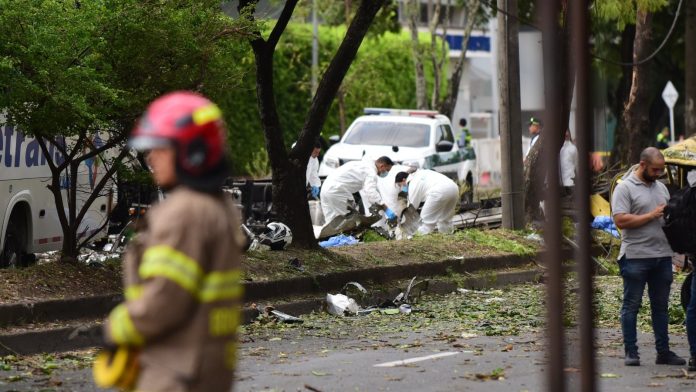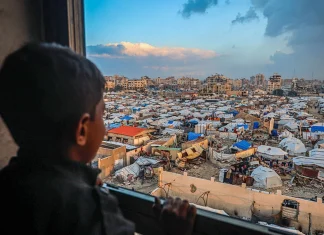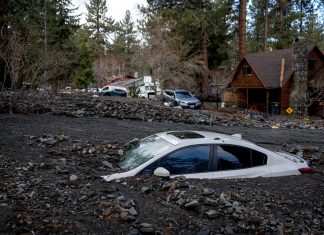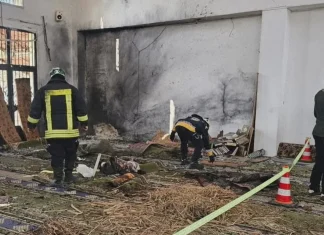
Colombia’s Shadows Deepen: Twin Attacks Ignite Fear as Peace Hangs by a Thread
In the early hours of a seemingly ordinary day, an explosion rippled through the streets of Cali, Colombia’s vibrant southwestern city known for salsa rhythms and bustling markets. Almost simultaneously, far to the north, a coca farm was plunged into chaos when a police helicopter was shot down by an unmanned drone. Between these two violent sparks—one a roaring truck bomb, the other a calculated airborne strike—at least 18 souls were stolen, and dozens more injured. These attacks are not just headlines. They are the latest pulse in the country’s paling heart, where peace is fragile and the ghosts of war refuse to stay buried.
The Aftermath in Cali: A City Shaken, a Community on Edge
It was just past noon when the thunderclap shattered the air near Cali’s military aviation school. Hector Fabio Bolanos, a 65-year-old local vendor, stood frozen in shock. “There was a thunderous sound of something exploding near the air base,” he recalled, his voice thick with disbelief. “People were crying, running—there were so many injured.”
Social media feeds overflowed with harrowing images: smoldering vehicles, mangled homes, and the anguished faces of survivors amid wailing sirens. The scene bore the chaos of a city abruptly unmade.
Mayor Alejandro Eder wasted no time. Declaring martial law over Colombia’s third-largest metropolis, he imposed an urgent ban on large trucks entering the city, a grim nod to the tactic used in the attack. His voice, though firm, carried a plea for calm and cooperation, promising a $10,000 reward for any information leading to the perpetrators. “This is our home,” he said in a press briefing. “We must protect it together.”
But protection is proving elusive. The group blamed—the Central General Staff, or EMC—is a splinter faction from the notorious FARC guerrillas, who signed peace accords in 2016. Yet a decade later, they have revived a specter of violence, unraveled trust in the peace process, and challenged the nation’s resolve.
A Drone’s Lethal Precision: The Northern Attack
While Cali reeled, far to the north, an even more modern menace took to the skies. A police helicopter, conducting operations near a coca plantation—a hotspot in Colombia’s ongoing drug struggles—was crushed mid-air by a drone equipped with explosives. This chilling new tactic foregrounds the growing sophistication of dissident groups and their adaptability in asymmetrical warfare.
Local resident Maria Gutierrez, whose family has farmed coca leaves for generations, described the moment with haunting clarity. “We heard a strange buzzing, then the sky lit up,” she said. “The helicopter spiraled down like a falling star. My children cried, but this has been our reality for too long.”
The use of drones in Colombia’s conflict marks a technological leap in guerrilla tactics, challenging authorities in new and unsettling ways. “We are witnessing an era where traditional methods of warfare are intertwined with cutting-edge technology,” explained defense analyst Juan Carlos Ramirez. “This raises grave questions about the future security landscape.”
Ripples Beyond the Violence: Colombia’s Fractured Peace and Upcoming Elections
These twin attacks strike at a critical juncture. With national elections looming next year, Colombia’s political fabric is tense and frayed. The steering wheel of peace, carefully guided by decades-long negotiations, feels unbalanced under the weight of renewed violence.
Since the landmark 2016 peace deal between the Colombian government and FARC, hopes were high that the worst of the conflict had passed. Yet, as the Central General Staff and other dissident factions operate from the shadows, the optimism dims.
Experts warn that these recent violent episodes are more than isolated events—they are symptoms of deep-rooted issues:
- Economic disparities: Marginalized rural areas still struggle with poverty and limited state presence.
- Drug trade dynamics: Coca cultivation persists, feeding lucrative black markets and forcing continuous clashes.
- Governance challenges: Weak institutions find it difficult to maintain authority in remote territories.
“We cannot ignore that peace isn’t just the absence of bullets,” remarked sociologist Daniela Perea. “It requires addressing systemic inequalities, healing communities, and fostering trust in institutions.”
The Human Cost: Voices from the Ground
Beyond the statistics lie faces marked by fear and resilience. Survivors of the Cali bombing speak of shock and sorrow, but also of an unyielding spirit. Luis Enrique, a taxi driver who rushed to help after the explosion, shared, “The city will heal. We always do. But the pain—this pain—it reminds us how fragile peace is.”
Katherine Montero, a nurse at a local hospital, recounted sleepless nights filled with triage and tears. “We tend to wounds of flesh, but we also treat trauma bound deep within hearts,” she said softly. “The question I ask myself every shift—how do we rebuild trust when violence returns like a recurring nightmare?”
Lessons for the World: A Microcosm of Conflict and Hope
Colombia’s struggle is in many ways a mirror held up to global tensions. As countries everywhere grapple with insurgencies, the role of new technology in combat, and the long shadow of historical conflicts, the South American nation’s story is a cautionary tale and a beacon.
Are we, as a global community, prepared to support peace beyond the signing tables? Can international actors help Colombia— and others caught in similar spirals—build durable futures that go beyond ceasefires? And crucially, can we listen to those who live in the eye of the storm?
Colombia’s latest chapter, stained with violence yet infused with the enduring spirit of its people, beckons for both attention and empathy. The road ahead is uncertain, but the urgent need for dialogue, justice, and inclusion rings louder than ever.
In Closing: Colombia’s Call to the World
As dusk falls over Cali and the northern coca fields, the hum of resilience resonates, even if faintly. Those who survived the blasts and the downed chopper are not just casualties—they are witnesses to a story still unfolding, a story that demands global awareness.
For those of us far from these troubled soils, what lessons will we draw? Will Colombia’s struggles merely fade into distant headlines, or will we engage with the complexities and share in the hope for peace?
The answers may shape not just Colombia’s destiny but the future of conflict and reconciliation worldwide.







